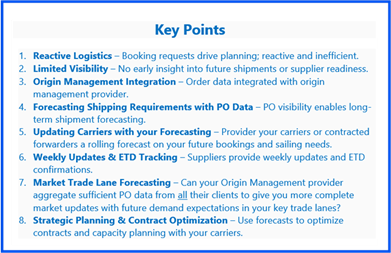In my early days as a global logistics director, planning was a constant race against time. The booking process took weeks, and once confirmed, we had mere days to load containers and get them to the port. It was reactive, inefficient, and stressful. We had no visibility!
We relied on booking management, which meant we didn't know what was coming until someone requested a shipment booking. That left us scrambling to secure space, align with sailing schedules, and meet delivery expectations. It worked, but barely.
The game-changer came when we integrated an origin management process with our order management system. Suddenly, we had access to purchase orders 60 to 90 days before shipping. That lead time gave us a forecast, a "hard cast" of what was coming. Every week, that forecast could be refined with updates from suppliers.
The Benefits of Origin Management for Shippers
With origin management, we gained:
- Early visibility: 10 weeks before sailing, we knew what was likely to ship
- Accurate forecasting: 4 weeks before sailing, we had a hard commitment to book against
- Flexibility: We had time for last-minute changes and could signal our intent to carriers
This level of visibility enabled us to make informed decisions about our shipments and improve our logistics operations.

The Future of Logistics: Aggregated Projections for All Shippers
But the real breakthrough comes if your order management provider can aggregate data from all their clients to forecast trade lane volumes. By anonymizing data, they can provide insights into market trends and capacity constraints. This can help all shippers, including BCOs (Beneficial Cargo Owners), make informed decisions about contract negotiations, capacity planning, and rate management.
With aggregated projections, shippers can:
- Anticipate market trends: Understand where trade lanes are heading and adjust strategies
- Informed decisions: Decide when to shift volumes, renegotiate rates, or secure space
- Optimize capacity: Adjust inventory management strategies based on expected volumes
This level of visibility can enable shippers to break down trade lanes into smaller sub-trade lanes, such as Southeast Asia to US East Coast or India Subcontinent to North Europe. By doing so, they can gain a more nuanced understanding of market dynamics and make more informed decisions.
The Power of Origin Management
Origin management paired with robust order data empowers smarter decisions. It's a game-changer for global logistics. Once you've seen the difference, there's no going back. By leveraging this data-driven approach, logistics professionals can stay ahead of the curve and drive business success in an increasingly complex and dynamic global market.





